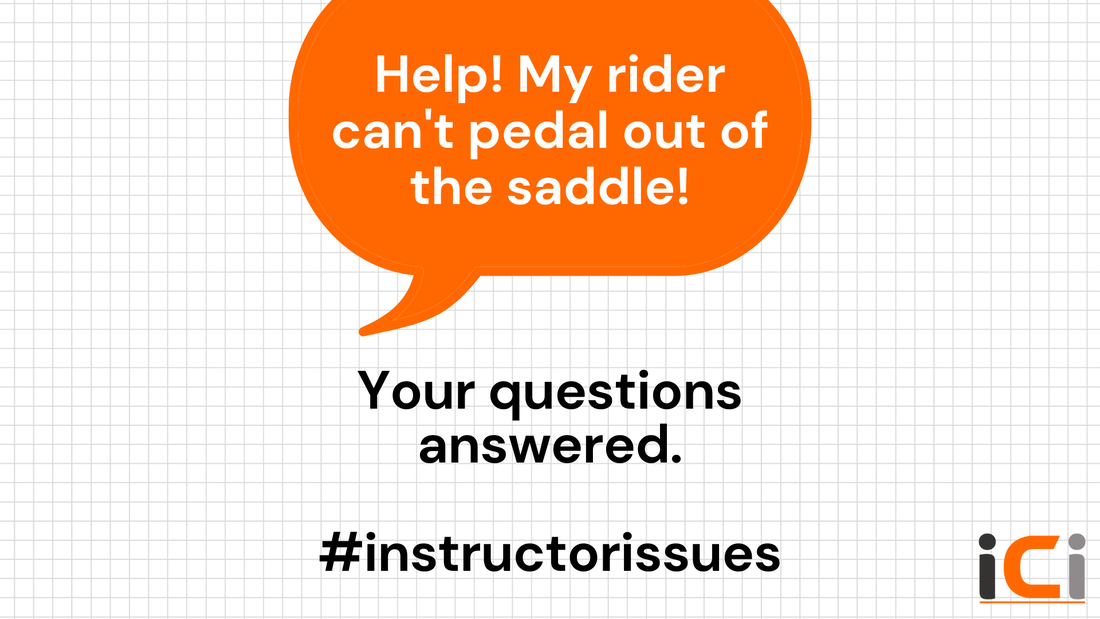by Angela Reed-FoxIndoor Cycling Instructor issues: My rider can't come out of the saddle for a standing climb!This is not an uncommon indoor cycling problem at all - particularly if you're doing a good job at reaching riders who wouldn't normally consider indoor cycling but who could get a great deal out of it. So if you have this type of rider in your class, take this as a great compliment! Why do riders struggle to come out of the saddle? There are several potential problems a rider might be experiencing; here are the main ones, and they're often interrelated:
Lack of confidence This is a very common problem. Many new riders have low confidence and a negative body image, and this is a major reason why new riders may come once and then not come back. There are two main ways to treat this problem:
Avoid running classes that are run like a choreography where it looks odd if a rider is not doing the same thing as everyone else. This is a surefire way of reinforcing a rider's low confidence if they're not able to do everything that other riders can do. The beauty of indoor cycling is that you don't need to have rhythm, to be able to feel and match a beat, you don't need to be fit to get started, and you can go at your own pace and adjust your resistance yourself and no one needs to know. It's good for riders to be reassured that others don't know what they're doing. They can then enjoy exercising in a group, enjoy the camaraderie but not feel like they're being judged. You can build confidence by offering options. Every option you offer needs to be a positive one - enable your riders to win every time. Think about how you would feel if you were new to indoor cycling, you though everyone was fitter than you, you'd not been on a bike since you were a kid, and you were pretty confident you were the heaviest one there? Chances are that unless you've been that person, you can't know exactly how that feels - but you can imagine, and as an instructor it's important to have empathy and make the way easier for those who might be struggling. For my first ever indoor cycling session, I stayed in the saddle for the whole time. When everyone else was up out of the saddle and loving life, I was plodding along at the back hoping no one noticed. I was worried that if I came out of the saddle I would feel unsteady and maybe fall off. I hated the session from start to finish and vowed never to do another indoor cycling session ever again. Life had other plans, obviously - but how many others have had a similar experience? And it's not always going to be the riders you expect. I was young, a healthy weight and reasonably fit. I just had low confidence and was terrified of falling off and being laughed at by the fit people. You can't spot that, and no rider is going to tell you that that's how they feel. What would have helped would have been if the instructor noticed that I seemed incapable of doing what everyone else was doing, and just gave some simple, yet positive, options to the whole class so I didn't feel singled out. If he'd have said that we were all welcome to ride in the saddle but just add a little more resistance and that this would work our glutes harder, I would have not felt like such a loser. Incorrect bike setup Check the rider's bike setup. If the saddle is set too low (and it often is if the new rider has set up themselves on the bike) this will make it much harder to come out of the saddle in the first place as they're having to push much harder with their legs to get up. Poor core strength This is a prevalent problem for many new riders. The good news is that core strength does build quickly. To help them do this, a tweak to the bike setup will help - try raising their handlebars slightly so that when they're out of the saddle they're more upright than leaning forward - this will help them to stabilise. You can alter the bike setup as they get stronger and more confident. The best way to build core strength (and also confidence and self-esteem) is with tiny challenges. Create easy wins. Can your rider come out of the saddle for TWO seconds? Work on the smallest increment possible. Once they've got the hang of two seconds, you can go for longer, but only increase bit by bit and make sure they win each time. Those with lots of confidence are happy to take on big challenges as they're confident they can get there, but those lacking in confidence will need tiny challenges so the reinforcement of repeatedly 'winning' can help to build their confidence. Once the rider has managed 5 seconds out of the saddle, when you have a standing climb ask them to join in for the first 5 and for the last 5 so they're starting and finishing with the others. Back problems or pain When the rider registers for class, you should have access to their PARQ and should know what issues they have decided to share with you. You'll still need to check with them. Backs are complicated. If they have an upper back, neck or shoulder issue, they might feel more comfortable with higher handlebars. Always check with new riders and explicitly ask about neck, back and shoulder issues. If you and they are reassured that they are safe and happy to ride, great. If you think they need to be referred back to their doctor or nurse before they undertake a class, as a responsible instructor you should do this. Balance problems These can be long or short term. An inner ear infection can last for a few weeks but can cause havoc with balance. Dyspraxia or neurological issues such as Parkinsons can mean balance is permanently impaired. Whichever it is - it's going to require patience, and options. In some cases the balance problem might be permanent and they will need permanent options in order to be able to take a class. As they come more often they'll be more in touch with what they can do, and will feel more and more comfortable sometimes doing something that the others are not doing. Reassure them that this is absolutely fine. Everyone is different, and you want each rider to get a great workout and have a good time. Incorrect resistance New rider logic dictates that the resistance and the cadence must be high. If the resistance is too high, the rider is going to struggle to turn the pedals in or out of the seat. If the resistance is too low, the rider is going to be unsteady out of the saddle as the pedals fall away towards the bottom of the pedalstroke. Describe the intensity with each challenge, let them know how it should feel. Try these suggestions - quality indoor cycling changes lives, and when you're dealing with these sorts of problems you're part of a tremendous solution. Was this useful? Check out the Indoor Cycling instructors' Handbook which contains all sorts of help with planning sessions, delivering classes and class management.
If you're an instructor already, check out our CPD courses too.
0 Comments
Leave a Reply. |
Categories
All
|
Quick links
Get started
|
Find what's right for you
|
Courses
|
Further learning
|
More
|
The Indoor Cycling Institute provides the most comprehensive and up to date indoor cycling instructor training; providing entry-level courses, and further education to raise the standard of instructors.
© 2014-2024 Protheorem Ltd
The Indoor Cycling Institute is owned and operated by Protheorem Ltd Registered in England & Wales, Company number 12812092
The Indoor Cycling Institute is owned and operated by Protheorem Ltd Registered in England & Wales, Company number 12812092




